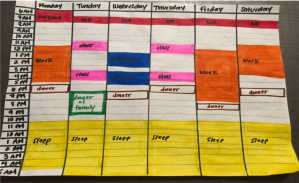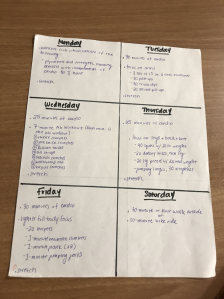DISCLAIMER: I am NOT a qualified personal trainer, doctor, dietician, or any other health professional. This article is based on my personal experiences and what I have found successful in my own growth in health and wellness. Reading this is a good start to move towards your goals of exercising, but make sure to do more research to tailor workouts towards your specific goals. I recommend talking to your primary care physician or discussing plans with a dietician/personal trainer, to successfully make a workout plan for your specific needs.
Goals: What is your intended goal in making this workout routine?
Having a realistic and attainable goal not only helps with seeing a physical vision for yourself, but it also instills an internal motivation to reach those goals. This should be one of the first steps you approach when starting a workout plan for yourself. Why do you want to workout more? Here are some common goals that people tend to focus on when planning a workout routine:
- Become healthy in general
- Lose excess weight
- Reinforce healthy eating and other good habits
- Gain strength and muscle
- Perform in a body competition
- Condition for sports
Once you focus on a specific goal, you can move towards your next plan of action: a workout routine! For this article, I am going to focus on the goal of losing weight to make a basic, beginners routine for those looking to follow this long-term change.
Schedule: Figuring out when to implement workouts
One of the biggest challenges is finding the time to fit a 30-minute to hour-long workout into your busy day. One activity that I find extremely helpful when managing my time is the following:
Step 1: Get a piece of blank paper
Step 2: Draw a diagram with hour-by-hour ticks on one side and days of the week on the other
Step 3: Write out your entire week schedule onto this piece of paper
Below, I have an individualized example of this exercise, where I mapped out my schedule by color-coding classes, club meetings, and other times I know I am busy to show where I can fit in a workout. I did not include Sundays because those days are my official rest days.

When planning your workout, you might think you have absolutely no time to workout during your busy week. Most of the time, this isn’t true! Mapping out your schedule into a tangible, colorful depiction of your week helps to show what times you have available to work out. Actually planning out times to go to the gym or workout will establish a routine in itself and help you with motivation and planning.
Types of Workouts
Since different goals require different workout approaches, I am going to focus on making a routine geared towards beginners who have the goal of losing weight and getting in shape. Areas that you want to focus on include the following: cardio workouts, strength training exercises, and active recovery. Here are some definitions to make more sense of these areas:
- Cardio workouts, also known as cardiovascular exercises, incorporate large muscle movements over a sustained period of time, which helps burn fat and strengthen muscles. Some low-impact and common examples include the following: walking, cycling, elliptical training, jogging, swimming, and more.
- Strength training increases lean muscle while improving muscular strength and endurance, through the use of repetitive bodyweight movements/weight-training. This form of exercise burns fewer calories an hour compared to cardio exercises, which has caused people to believe that cardio should be the main way to lose weight. However, strength training is AS important as cardio, since it increases metabolism rates over time while building muscle that can contribute to burning more calories. Examples of strength training exercises include lifting weights, yoga, pilates, and more. It may be easier to focus on specific body sections when doing these exercises (e.g. “leg day”).
- Active recovery refers to recovery within and outside of physical exercise. Though exercise is beneficial for the body in general, it is important for the body to have days where muscles can recover before being worked on again. Rest is important, but moving sore muscles and keeping up the habit of activity is a must when moving towards a healthy exercise routine. Some examples of active recovery include low-impact exercises (e.g. walking) or stretching routines. This part of your exercise routine should be more relaxed since this is most beneficial when recovering from intense workouts.
Other Things to Think About
Though exercising is extremely important, many other factors contribute to your health and, in some situations, might even override the importance of working out. For example, when people start exercising to lose weight, many forget about the most important factor when trying to see tangible results: food intake and diet in general. If we do not follow a proper diet regimen that assists in properly fueling the muscles and body, we are losing the benefits we gain from working out in the first place! BUT, this does not mean that one should limit themselves to caloric intake or eating in general. One method that many people rely on, including me, is the incorporation of mindful eating. Mindful eating has taught me to have a healthy relationship with food, while also showing myself how I can create a healthier approach to choosing what is best for my body and my health needs. Mindful eating, in short, is an approach to eating that follows the philosophy of listening to the body and spending time “in the moment” when thinking about hunger and satiety. Other factors that need to be considered when planning and incorporating a workout routine include the following:
- Academic life: How will you balance this with studying and keeping up with schoolwork?
- Work life: How can you schedule around your job when trying to make a workout schedule?
- Mental health: How is this going to affect your mental health? Make sure you are paying attention to anxiety or stress geared towards overcommitment to exercise. It is okay to take a break to sleep in or do other things!
- Sleep: How can you incorporate workouts into your schedule without decreasing the amount of sleep you are getting?
- Social life: How can you make time for both friends/family and exercise?
- Personal time: Are you allowing yourself to have some alone time, where you can decompress and do activities outside of exercising?
Be mindful that your routine could change over time depending upon how other events in your life change. Making sure you are happy with the changes you are instilling in your life will allow you to actually enjoy your workout routine and accept a healthier lifestyle.
Exercising is a versatile way to not only become physically healthier over time but to also relieve anxiety/stress and instill positive self-care mechanisms into your daily life. Remember, you are doing this for YOU!
Mock Schedule: Beginners Workout Routine

-Francesca Cocchiarale

